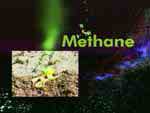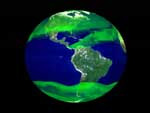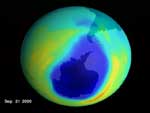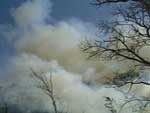January 14, 2002 -(date of web publication)
Click here for Official NASA Press Release
AN ALTERNATE SCENARIO FOR CLIMATE CHANGE
Until recently, experts believed that reduction of atmospheric carbon
dioxide might be the best way to confront continued climate
change. Yet in a world that, for the time being, still is
tied fundamentally to power from fossil fuels, significant
additional carbon dioxide reductions present daunting practical
challenges. But a new report from The Goddard Institute for
Space Studies highlights data indicating that greenhouse gas
emissions have dropped due to concerted efforts by governments
around the world. According to this new study, an "alternate
scenario" to understanding climate change might provide
guidance for successfully curtailing climate altering factors
without requiring unreasonable demands of both industrialized
and developing countries.
Image 1
Click here for a higher resolution version of Image One
Click here for reporter's package
MORE THAN JUST CARBON DIOXIDE
Methane: a simple compound made of carbon and hydrogen, this gas comes
from ordinary sources, like cattle herds and garbage dumps.
On a planetary scale it also has a significant impact on climate.
As it builds up in the atmosphere, it traps energy from the
sun like a layer of insulation.
Carbon dioxide does much the same thing-it causes global warming
by trapping heat. But as experts struggle to curtail global
climate change, a decrease of atmospheric methane might be
easier to achieve than proportional drops in carbon dioxide,
affording an alternate scenario to policy makers.
Image 2
Click here for a higher resolution version of Image Two
Click
here for an animation of methane circulation
THE METHANE CONNECTION
The list of traditional climate change culprits usually begins
with carbon dioxide. But a new report coming out this month
suggests that policy makers consider alternatives-alternatives
that might bring serious threats to global climate stability
under control.
Methane is one of the principal targets. Although only half
as much a factor in global warming as carbon dioxide, researchers
say that it is significantly easier to curtail, thus affording
greater potentials for meaningful effects.

Image 3
Click
here for animation of methane cycle without audio
HUMBLE ORIGINS, PROFOUND IMPLICATIONS
Methane is second only to carbon dioxide in contributing to global
warming. It is a naturally occurring gas, a product of a variety
of biological processes. But in terms of climate change, it
is the unnatural concentration of the gas from human induced
factors that has researchers concerned. In the case of garbage
disposal, methane enters the atmosphere as a byproduct of
decomposition. As anaerobic bacteria break down polymers and
other carbon based garbage, like the banana peel shown here,
methane gets produced as a waste gas. As it enters the atmosphere,
it reduces the Earth's ability to cool by absorbing more reflected
heat from the planet than would otherwise occur.
Other sources of methane production include rice cultivation,
industrial production, and cattle herds.
Image 4
Ozone hole
Click here for a higher resolution version of Image Four
A ROGUES GALLERY OF GREENHOUSE GASSES
Methane is not the only greenhouse gas that has the attention
of experts. Carbon dioxide, ozone in the troposphere, black
carbon soot, aerosols, nitrous oxide, and several types of
halocarbons all contribute to climate change.
Image 5
Smoke and aerosols
Click here for a higher resolution version of Image Five
While carbon dioxide is may be the biggest single factor in overall global warming, reduction of the other contributing gasses may have the potential of greater climate change mitigation.
Image 6
Carbon dioxide from fossil fuels
Click here for a higher resolution version of Image Six
The reasons for this are complex and require additional research,
but experts say that methane and its non-CO2 counterparts
not only have the potential to cause more warming kilogram
for kilogram, but also may be more easily reduced than CO2.
Image 7
Global carbon monoxide
Click here for a higher resolution version of Image Seven
GREENHOUSE EMISSIONS GROWTH SLOWED OVER PAST DECADE
A new NASA-funded study shows that the rate of growth of greenhouse gas emissions has slowed since its peak in 1980, due in part to international cooperation that led to reduced chlorofluorocarbon use, slower growth of methane, and a steady rate of carbon dioxide emissions.
Researchers have shown that global warming in recent decades has probably been caused by carbon dioxide (CO2), and other greenhouse gases including chlorofluorocarbons (CFCs), methane, tropospheric ozone, and black carbon (soot) particles.
Overall, growth of emissions has slowed over the past 20 years, with the CFC phase-out being the most important factor, according to the study.
"The decrease is due in large part to cooperative international actions of the Montreal Protocol for the phase-out of ozone depleting gases," said Dr. James Hansen of NASA's Goddard Institute for Space Studies, New York. "But it is also due in part to slower growth of methane and carbon dioxide, for reasons that aren't well understood and need more study."
The findings appeared in the December 18 issue of the Proceedings of the National Academy of Sciences. Hansen co-authored the paper with Makiko Sato of Columbia University, New York.
The warming effect of methane is about half as large as that of CO2, and when methane increases it also causes a rise in tropospheric ozone levels. Tropospheric ozone is a principal ingredient in "smog," which is harmful to human health and reduces agricultural productivity. The rate of methane growth has slowed during the past decade, and it may be possible to halt its growth entirely and eventually reduce atmospheric amounts, Hansen and Sato suggest.
Another warming agent deserving special attention, according to the authors, is soot. Soot is a product of incomplete combustion. Diesel powered trucks and buses are primary sources of airborne soot in the United States. Even larger amounts of soot occur in developing countries.
The study also suggests that reduction of methane emissions and soot could yield a major near term success story in the battle against global warming, thus providing time to work on technologies to reduce future carbon dioxide emissions. Currently, technologies are within reach to reduce other global air pollutants, like methane, in ways that are cheaper and faster than reducing CO2.
Though reducing these climate-forcing agents is important, scientists caution that limiting CO2 will still be needed to slow global warming over the next 50 years.
Hansen emphasizes that CO2 emissions are the single largest climate forcing, and warns that they need to be slowed soon and eventually curtailed more strongly to stabilize atmospheric conditions and stop global warming. Over the next few decades, Hansen said, it is important to limit emissions of forcing agents other than CO2, to buy time until CO2 emissions can be better managed.
If fossil fuel use continues at today's rates for the next 50 years, and if growth of methane and air pollution is halted, the warming in 50 years will be about 1.3 degrees Fahrenheit (0.7 Celsius). That amount of warming is significant, according to Hansen, but it is less than half the warming in the "business-as-usual scenarios that yield the specter of imminent disaster."
The climate warming projected in the Institute scenario is about half as large as in the typical scenario from the report of Intergovernmental Panel on Climate Change (IPCC). This is because the IPCC considers a large range of forcings and models. The warming in the GISS model is similar to the lowest of the IPCC results, despite the fact that the GISS model has a relatively high sensitivity to forcings.
Graphics for Press Release--Estimated Climate Forcings Today Compared With 150 Years Ago
Image 8
Click here to enlarge image
This graphic depicts changes in 12 climate "forcings" or factors that have contributed to climate change since 1850.
These agents can be categorized into three areas: greenhouse gases, other man-made (anthropogenic) forcings, and natural forcings. The greenhouse gases consist of carbon dioxide (CO2), methane (CH4), nitrous oxide (N20) and chlorofluorocarbons (CFCs). The other anthropogenic forcings consist of black carbon (soot, formed by incomplete combustion), reflective aerosols (tiny airborne particles that reflect sunlight back to space), soil or dust, land cover changes, and forced cloud changes. Natural forcings include changes of the sun's energy and changes of aerosols from volcanic eruptions.
The total "forcing" of climate since 1850 includes a "positive" effect from all the greenhouse gases, which would have a warming effect. Of the other anthropogenic forcings, black carbon has also had a "positive" effect, whereas the other factors including: aerosols, soil and dust, cloud changes, and land cover alterations have had "negative" or cooling effects. Of the natural forcings, an increase of the Sun's brightness has caused a positive forcing, while variations of volcanic aerosols have caused both positive and negative forcings.
Although the sum of all forcings coincidentally is similar to that for carbon dioxide alone, knowledge of each of the large forcings such as methane and black carbon (soot) is needed for development of effective policies.
NOTE: The image depicts the growth rate of estimated climate forcings by well-mixed greenhouse gases (5-year mean, except 3-year mean for 1999 and 1-year mean for 2000). Ozone (O3) and stratospheric H2O, which were not well measured, are not included.
Growth Rate Of Climate Forcings By Greenhouse Gases
Image 9
Click here to enlarge image
Climate forcings, or factors that promote warming, such as emissions
of carbon dioxide (CO2), methane (CH4), nitrous oxide (N20)
and chlorofluorocarbons (CFCs) have increased in the world's
atmosphere since the technology of the industrial revolution
began pumping these into the atmosphere beginning in the 1800s.
In the graph, climate forcings due to CO2 increases are depicted
in light blue, CH4 in dark blue, N20 in yellow, and CFCs in
red.
In a new study, James Hansen of NASA's Goddard Institute for
Space Studies and Makiko Sato of Columbia University found
that the growth rate of climate forcings have slowed substantially
from almost 5 Watts/meter2 (W/m2) per century to about 3 W/m2
since their peak in 1980.
A watt is a unit of energy and a "watt per meter squared"
is the amount of energy the forcing agents have over an area
of one square meter. Typically, a forcing of 1Watt after 50
years of would yield a warming of 1.35ƒF (3/4ƒC)
by 2050 in changing climate model simulations. The peak in
the mid-1980s and drop in the late 1980s of CFCs is evident
in the reduction of the red colored area on the graph toward
the end of the 1980s.
"The decrease is due in large part to cooperative international
actions of the Montreal Protocol for the phase-out of ozone
depleting gases," Hansen said. "But it is also due
in part to slower growth of methane and carbon dioxide, for
reasons that aren't well understood and need more study."
Hansen and Sato report that emission trends need to be further reduced to approximately 2 W/m2 per century for the next 50 years to achieve a "moderate climate change scenario."







